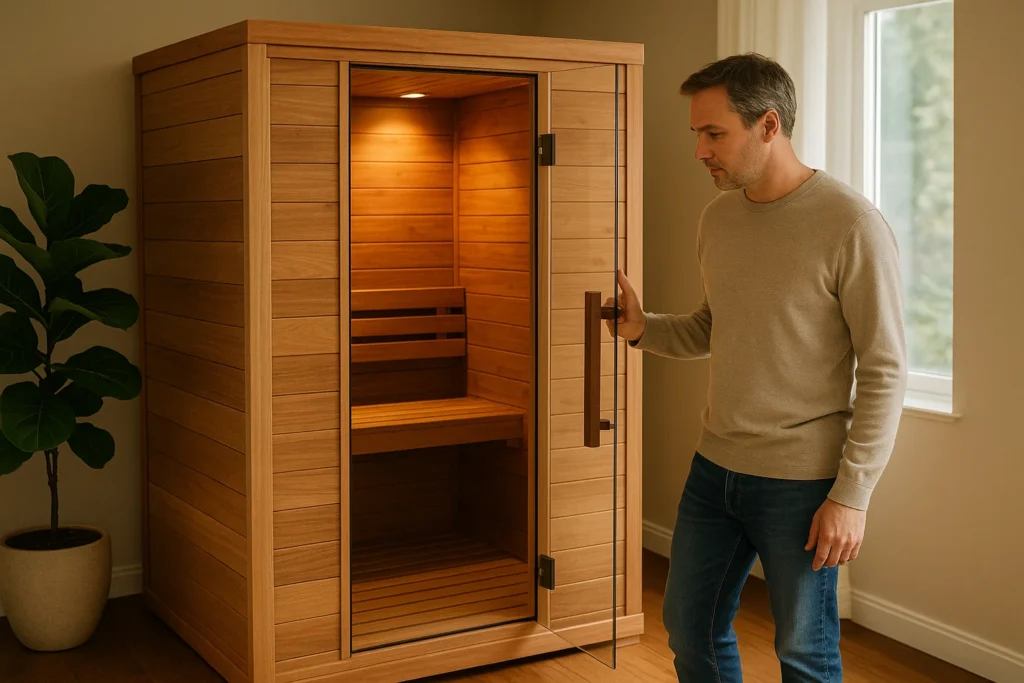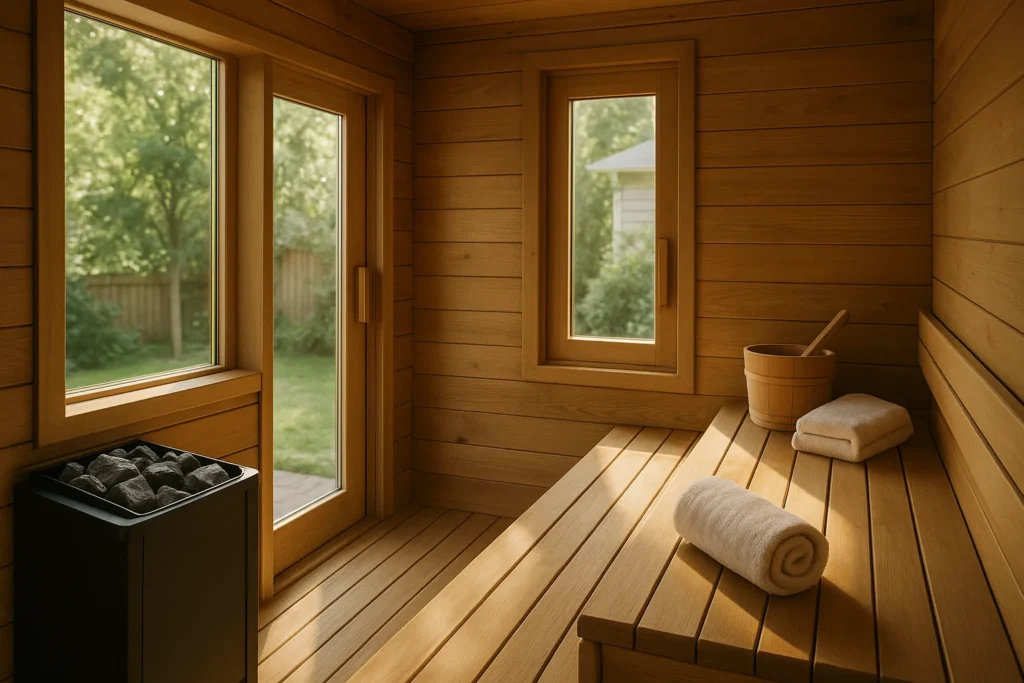Do you ever wonder how it would feel to have a soothing place in your own home? If this is your case, then a sauna is perhaps the best accessory to have. Nevertheless, whether it is the end of the day, the tightened muscles, or the health benefits associated with a heat treatment, a sauna can make a difference to your personal wellness experience. But with such a range of them on offer how can you make the right choice?
Sauna Buying Guide welcome! Here, in this friendly and easy to read guide we will walk through what you need to know, the type of saunas you can use in a home setting, the benefits of saunas, choosing the right type of saunas, how to take care of your saunas, and whether you should resize the rooms like the bath in your home. After reading this, you should be at ease with addressing the relaxation and comfort of a sauna to your home or office.
What to Consider When Buying a Sauna
It would be remiss not to pause here and consider your lifestyle, your budget, and the space that you have available before examining types and features. Some of the factors that you need to consider before you buy:
- Space & Location: Where do you want your sauna to be located, and are you looking to have it indoor or outdoor? How much room is atNone Convex? Measure carefully.
- Price: Saunas come in all prices. Make a decision entering the amount you will invest upfront and in maintenance.
- Material & Build quality: Ensure the quality of the wood you get (maybe cedar or hemlock) is able to withstand heat and moisture.
- Type of heat: Electric, wood-burning, or infrared? Each has its difference of advantage and installation requirement.
- Capacity: Will it be occupied by one person, two people or a family? There are a variety of saunas in terms of size.
- Ease of installation: Some are plug and play, some have to be installed professionally.
- Maintenance Requirements: Take into consideration materials and design, which are easily maintained and cleaned in the long-term.
Types of Saunas for Home Use
One of the most exciting parts of purchasing a sauna is finalizing the type that grants the best fit to both home and way of life. By knowing what each of the options entails, this decision will become simpler, and more pleasant.
Traditional Finnish Sauna
The Traditional Finnish Sauna is the opportunity many people picture in their minds when they think of a sauna. It operates an electric or wood-fired stove which heats the air inside a wooden room, with temperatures usually being between 150°F and 195°F. This sauna has high-heat and low to moderate humidity levels, so you can enjoy intensive heat and get a deep relaxation and detoxification. However, it requires more time to warm up and occupies a larger space, and requires efficient ventilation in order to allow a safe and comfortable interaction process.
Infrared Sauna
The Infrared Sauna has been popularized by its heating process. Infrared heaters warm your body, instead of the air, at lower temperatures (usually between 120°F and 140°F). This reduces time taken to warm up as well as energy consumed as opposed to the traditional method. Infrared saunas make a good option when it comes to relatively small areas or someone that would appreciate a less harsh and abrupt radiating heat. The use is different compared to classic saunas and may not pass the taste of sauna professionals, however, most of them use it and are very comfortable and effective.
Steam Sauna (Steam Room)
A Steam Sauna also known as a Steam Room is a type of heat-generating tool that makes use of a steam generator to bring moist heat. Temperatures typically range within 110°F and 120°F but at 100% humidification, producing a light, soothing warmth which is most helpful to skin conditions as well as the respiratory system. Steam saunas need building requirements that are water-proof and tend to take longer to cool off after use but provide a deep cleansing and moisturizing effect.

Portable Saunas
Portable Saunas typically refer to the infrared type which are convenient in nature. These saunas are space-saving, portable and simple to put away when not ready in use. Portable saunas offer a cost-efficient variation in saunas, where one can get away with starting to experience sauna benefits with minimal investment. Their size and strength is however limited. All of these types of sauna have their various pros and cons, so consider your space, preferences and goals as you decide on finding which kind of sauna feels like the perfect addition to your home.
Benefits of Owning a Sauna at Home
Nothing is more than just unique home decoration; owning a sauna means a commitment to being healthier and relaxing. Here’s why adding a sauna to your home is a fantastic idea:
Physical Health Benefits
- Detoxification: The sweating removes wastes and toxic elements.
- Better Circulation: Heat increases blood circulation and can positively affect the health of the heart.
- Pain Relief: Super to use after exercise or a long day sore muscles and sore joints.
- Skin Health: Cleans the skin, opens pores and leaves the skin looking healthy.
Mental and Emotional Benefits
- Stress Reduction: The environment is warm and quiet and this helps in the relaxation of stress and anxiety.
- Improved Sleep: Sauna users record an enhanced sleep after the session.
- Better Mood: Heating intense endorphins, and you are feeling happier.
Convenient Relaxation
- At Your Fingertips: You do not have to drive to a spa or gym because your sauna is available any time.
- Privacy and Comfort: There are no distractions and you can use your sauna in the comfort zone within your own privacy.
- Social Space: ideal spot as a gathering room or family time wellness.
How to Choose the Best Sauna for Your Home
Choosing the perfect sauna means balancing features, space, goals, and budget. Here’s a straightforward checklist to help guide you:
Assess Your Space
Start by deciding whether your sauna will be either indoors or outdoors. Measure the available room size and ventilate to have a safe and comfortable environment. Make sure there are accessible electrical outlets or clearance when using a wood stove.
Decide on Heating Type
Pick a heating style that suits you: Traditional saunas are high heat saunas, infrared saunas warm up faster and at lower temperatures, and steam saunas are high humidity saunas. The two types provide different experiences that are aligned to the needs.
Choose Size and Style
Consider who will use the sauna the most frequently. The smaller saunas suitable to 1-2 persons can be very well used as personal relaxation places and the larger can be used to accommodate a family or a group of guests. To get a complete harmony, but the design that suits your style of home decor.
Consider Budget and Brand
Establish a definite budget that will include the sauna, the installation, and its maintenance. Check out good brands with a good reputation that come with warranties and good reviews so that you are guaranteed a long-lasting quality. Also consider long-term costs such as energy costs and repair costs.

Look Into Installation and Maintenance
Find out whether your preferred sauna requires a professional set up or not and check the electrical capacity of your home. Use materials that are low-maintenance, like treated wood, to ensure your sauna doesn’t require too much maintenance so that it continues to look and work well.
Sauna Installation and Maintenance Tips
A sauna is a long-term investment. Proper installation and maintenance ensure it stays safe, efficient, and beautiful. Here’s how to care for it:
Installation Tips
- Professional Help: Call in pros to do wiring to power or wood stoves.
- Proper Ventilation: A Must for Indoor Saunas to Avoid Moisture Problems.
- Firm Level Floor: Sauna should have a solid floor which is level.
Maintenance Tips
- Regular Cleaning: Clean benches, walls and floors after use.
- Wood Treatment: Apply sauna suited timbers oils from time to time to safeguard the wood.
- Check Electrical Components: Inspect heaters and controls yearly.
- Air Out: After use leave the door open and allow it to air dry.
- Avoid harsh Chemicals: Use mild cleaners in order to preserve the wood.
Conclusion
Inviting a sauna into your house is all about a personal oasis that will be able to soothe your body and mind. This Sauna Buyer Guide has equipped you with all you need to know to make a wise choice- the wide range of sauna types, their tremendous benefits, and tips on how to choose and maintain your sauna.
At All Star Construction Group, we want to help you incorporate wellness into your everyday life through quality workmanship and professional recommendations. Feeling like pulling in, a recharge, and rejuvenating right in your own home? Your ideal sauna today.
FAQ’s
The average traditional sauna takes 30-45 minutes whereas infrared saunas require 10-15 minutes to heat up.
Absolutely! Outside saunas are quite common and ensure that you withstand the weather elements and install properly using weatherproof material.
Clean off after every use and a deep clean every few weeks depending on usage.
To the largest extent, yes, although some people with specific conditions or during pregnancy, should consult a doctor before use.
Infrand saunas target the body directly at a lower temperature whereas a traditional sauna warms the air to a hotter environment.


